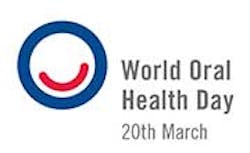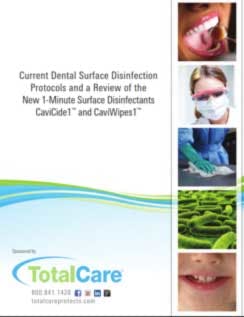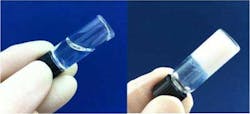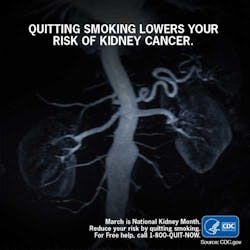Disease prevention a key part of health care
Product information that is necessary to provide a safe workplace environment includes knowing what surfaces a product can be used on, potential toxicity on skin, required contact time for disinfection, and compatibility with other chemicals and materials. Protocols for surface disinfectants that provide a safe, rapid effectiveness against tuberculosis and other infectious diseases are highlighted, as well as products that are compatible with common dental office materials.(5)
Liquid bone to gel, and back again? Bioengineers have developed a hydrogel scaffold for craniofacial bone tissue regeneration that begins as a liquid, solidifies into a gel in the body, and liquefies again for removal.(6) The soluble liquid at room temperature can be injected where it is needed. At body temperature, the material turns instantly into a gel to help direct the formation of new bone to replace that damaged by injury or disease.(6) For more information, read the press release and the article.(6,7)
An injectable hydrogel scaffold undergoes rapid gelation from a soluble liquid at room temperature (below left) to form a stable, non-shrinking gel at body temperature (below right) after one minute.
March is designated National Kidney Month to raise awareness about the prevention and early detection of kidney disease. In 2011, kidney diseases were the ninth leading cause of death in the United States(10). More than 10% (>20 million) of U.S. adults aged ≥20 years have chronic kidney disease [CKD].(2) The chances of having CKD increase with age; the disease is most common among adults aged >70 years. There is a very up-to-date National Chronic Kidney Disease Fact Sheet, 2014 available.(11)
On a positive note, colon cancer incidence rates have dropped 30 percent in the U.S. in the last 10 years among adults 50 and older due to the widespread uptake of colonoscopy, with the largest decrease in people over age 65.(12) Colonoscopy use has almost tripled among adults ages 50 to 75, from 19 percent in 2000 to 55 percent in 2010. Yet one more example of how prevention, screening, and early intervention works!
References
1. http://www.worldoralhealthday.org/.
2. https://www.ada.org/sections/advocacy/pdfs/ADA_AfDH_Prevention.pdf.
3. Maresz KJ, Hellvard A, Sroka A, Adamowicz K, Bielecka E, et al. (2013) Porphyromonas gingivalis Facilitates the Development and Progression of Destructive Arthritis through Its Unique Bacterial Peptidylarginine Deiminase (PAD). PLoS Pathog 9(9): e1003627. doi:10.1371/journal.ppat.1003627.
4. http://www.medicalnewstoday.com/releases/273631.php#citations.
5. http://hs.kerrtotalcare.com/hs-fs/hub/164363/file-18246937-pdf/docs/andrewskelsch_white_paper_web.pdf.
6. Vo TN, Ekenseair AK, Kasper FK, and Mikos AG. Synthesis, Physicochemical Characterization, and Cytocompatibility of Bioresorbable, Dual-Gelling Injectable Hydrogels. Biomacromolecules, 2014, 15 (1), pp 132–142. December 10, 2013. DOI: 10.1021/bm401413c.
7. Press release. Liquid to gel to bone. http://www.eurekalert.org/pub_releases/2013-12/ru-ltg121113.php.
8. http://www.cdc.gov/cancer/dcpc/resources/features/ColorectalAwareness/.
9. http://www.cdc.gov/mmwr/preview/mmwrhtml/mm6309a7.htm.
10. Hoyert DL, Xu JQ. Deaths: preliminary data for 2011. Natl Vital Stat Rep 2012;61(6).
11. http://www.cdc.gov/diabetes/pubs/pdf/kidney_factsheet.pdf.
12. Rebecca Siegel, Carol DeSantis, Ahmedin Jemal. Colorectal cancer statistics, 2014. CA: A Cancer Journal for Clinicians, 2014; DOI: 10.3322/caac.21220.
Sincerely,
Maria Perno Goldie, RDH, MS
To read previous RDH eVillage FOCUS introductions by Maria Perno Goldie, go to introductions.
To read more about arthritis and dental hygiene, click here.






